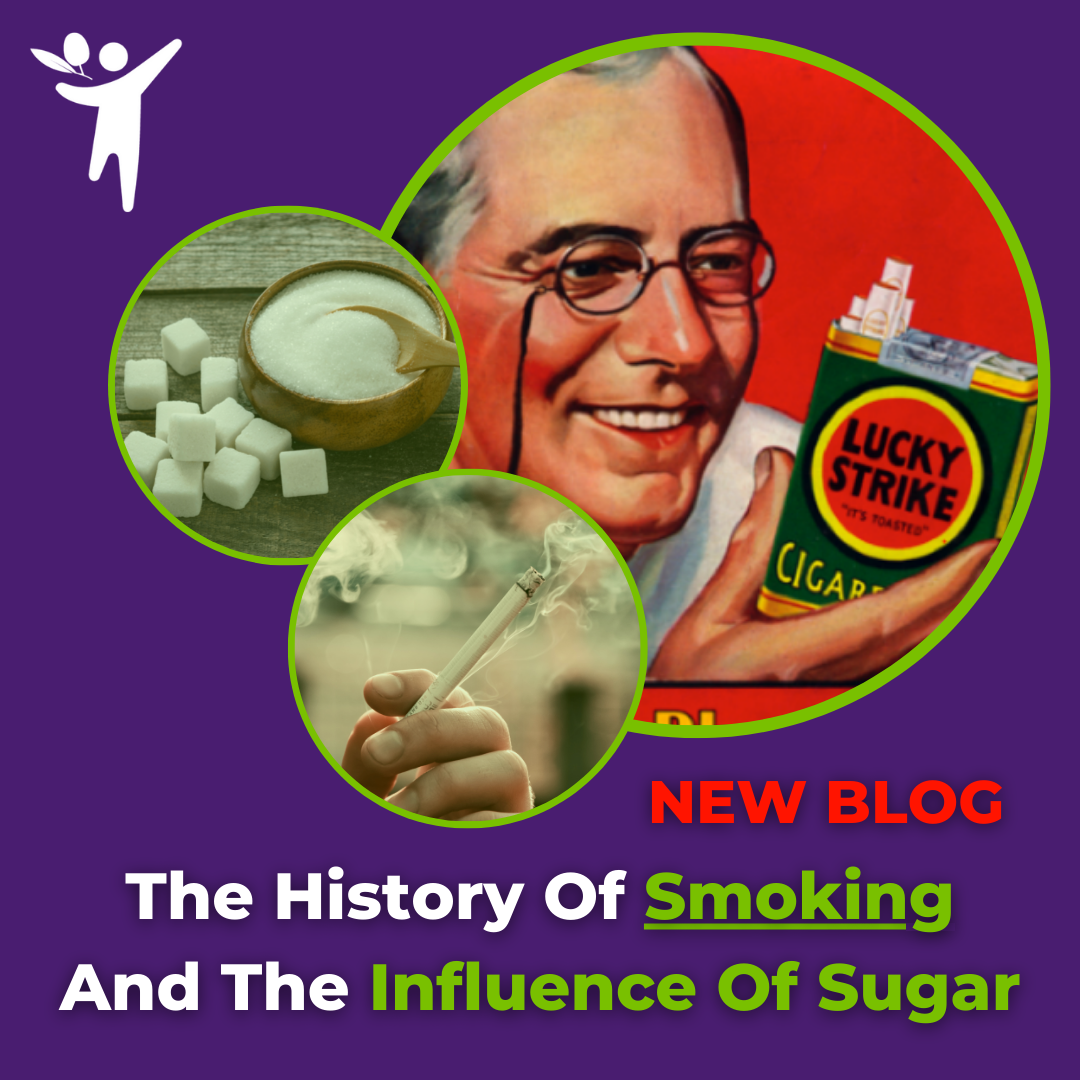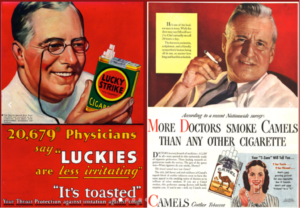History of smoking
The use of tobacco during religious or cultural celebrations and ceremonies dates back about 2,000 years.
During his voyages, Christopher Columbus first discovered tobacco smoking.
It was at Santo Domingo that tobacco was first cultivated in Europe (1531). By 1600, tobacco use had spread throughout Europe and England and was even used as a currency, a practice that continued into the twentieth century
In the 1700s, smoking became more popular and the tobacco industry developed.
An anonymous English author published a work in 1602 titled ‘Worke of Chimney Sweepers’ in which they proposed that illnesses commonly seen in chimney sweepers were caused by soot and that smoking might have similar effects.

Poor health was becoming increasing common and wreaking havoc in the population. There was a huge correlation with smoking, but people dismissed the connection because the tobacco industry heavily influenced the media. (Sound familiar?)
In the early 1900s, medical reports began linking smoking with lung cancer. Since tobacco companies advertised heavily in the media, many newspaper editors didn’t want to offend them by reporting the findings.
Many centuries later the tobacco industry was still flourishing but with a certain stigma attached to it. There was a growing public awareness of increasing rate of death and disability resulting from lung cancer. People began to worry and fear for their health as lung cancer rates were spiking drastically but there wasn’t a conclusive link that proved smoking was the root cause.
Cigarettes certainly cause coughing and throat irritation, but these are really minor symptoms. Nevertheless, marketers and advertisers seized this as an opportunity to sell their brand as “healthier” than their competitors. The marketing “tagline” was that not all cigarettes would give you health issues – just the competitors’ ones.
If you need help with adjusting your lifestyle choices and making that first step to living healthier for longer, we’re here to help. You can book your free 15-minute no-obligation consultation and take that step to better health.
‘Smoke the brand your doctor smokes’
Certain cigarettes cause less throat irritation, according to doctors! Tobacco companies in the 1930s and 1940s would proudly claim that cigarette was theirs. Smoking and lung cancer hadn’t yet been definitively linked, and most doctors smoked. To make their cigarette ads more credible, tobacco companies used doctors’ authority to promote their cigarettes.
Cigarette making machines were developed in the latter half of the 1800s. The first such machines produced about 200 cigarettes per minute (today’s machines produce about 9,000 per minute). Cheap mass production and the use of cigarette advertising allowed tobacco companies to expand their markets during this period.

Sugar companies helped tobacco companies with their bad reputation
With the negative health stigma attached, the production of tobacco started to shift. A certain amount of sugar is found naturally in tobacco, which is altered by the curing process. The flue-curing process increases sugar content in tobacco, increasing flavour and overall makes it more palatable to smokers while also decreasing nicotine content. Due to the lower levels of nicotine in the tobacco people again dismissed their health concerns and continued to make the tobacco industry ever richer.
By the early 19th century, the tobacco industry had established the way to make its product both more enjoyable to smoke and higher in nicotine. Burley tobacco is air-cured to produce a relatively high level of readily absorbed nicotine; sugar soaking, which follows, enhances the flavour of the tobacco.
In a short time, the “sugar-sauced” Burley tobacco began to appear in products made by RJ Reynolds’ Camels, which was followed by other manufacturers. More than 120 billion American cigarettes were “candied up” with over 50 million pounds of sugar each year by 1929.
A medical relations division was created by RJ Reynolds Tobacco Company and advertised in medical journals. Reynolds began paying for the right kinds of “medical” research and then quoting it in its ads. For example Reynolds created an advertisement in 1946 that stated, “More doctors smoke Camels than any other cigarette.” They asked doctors what brand they smoked, and then gave them a free carton of Camel cigarettes.
However by the mid-1950s (due to overwhelming medical evidence) tobacco companies had to accept that their products directly caused lung cancer. For this reason, their advertising strategies began to change.
Despite definitive research that firmly establishes the link between smoking and cancer, the tobacco industry TO THIS DAY argues that the evidence is “non-conclusive”. To obfuscate the issue, the industry formed a research committee.
As a result, cigarette ads ceased to feature doctors because they were no longer deemed convincing. The medical community became more and more anti-cigarette, which culminated in 1964 when the US Surgeon General published a report stating unequivocally that lung cancer, laryngeal cancer, and chronic bronchitis were all caused by smoking.
Despite this, tobacco companies still maintained, by leveraging their “research” committee, that the relationship between cigarettes and poor health remained “controversial”
Cardiovascular disease in the 20th Century
Most people from the higher class and high social status regarded smoking as a luxury. Everyone was doing it! Smoking rates were rising dramatically and sugar was involved in the production of cigarettes.
Tobacco was addictive enough but once companies like ‘Camels’ and ‘Luckies’ found out how to both include sugar and increase the nicotine content in the mass production of tobacco, they were unstoppable.
Celebrities, royalty, war-heroes, pregnant women and the youth were all either smoking themselves or surrounded by smokers. Everyone was doing it! The quality of the air was decreasing, and cardiovascular diseases were rising at an ever-faster pace.
President Eisenhower, the 34th president of the United States suffered a heart attack during his 1st term in office. This utterly shocked the nation, as he appeared to be a relatively “healthy” man. After extensive research the pathologists blamed dietary fats for Eisenhower’s poor-health.
Of course saturated fats were a significant element of the American diet during this period of history, but they were not the problem (nor have they ever been). Natural fats contain many essential micronutrients that are crucial for a healthy gut and body. The “problem” was never saturated fat but what we term “the trifecta of evil” – added sugar, processed carbs and processed food.
To learn more about how fats won’t kill you, please enjoy this blog.
President Eisenhower was a heavy smoker, his constant smoking was the likely cause of this heart attack not the amount of red meat or saturated that he ate.
In retrospect, it’s clear that Eisenhower died from a combination of factors such as the trifecta of evil, chain-smoking, lack of sleep, lack of nutrition, and lack of exercise. Overall, he certainly wasn’t the perfect picture of a healthy lifestyle. The one factor that did NOT bring about his demise? The much-scapegoated saturated fat
To learn more about fats and how they were scapegoated by the food and tobacco industries check out this podcast with Robert Lustig and Graham Phillips.
To learn more about the true causes of heart disease please watch this podcast with Dr. Malcolm Kendrick and Graham Phillips
To learn more about the Public health collaboration, a UK registered charity dedicated to informing and implementing healthy decisions for better public health please click here.
To learn more about myths surrounding cholesterol and solutions to heart diseases watch this podcast with Professor Aseem Malhotra and Graham Phillips.
The tobacco industry and its long association with sugar has severe impacts on our health and costs lives. ProLongevity will guide you toward a healthier lifestyle, with expert advice from our founder Graham Phillips. You can combat the “trifecta of evil” – added sugar, processed carbs, and processed food. ProLongevity is here to help you “Live Healthy for Longer”





